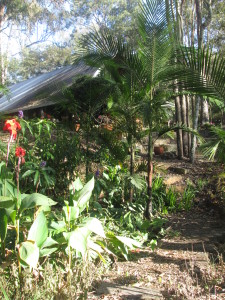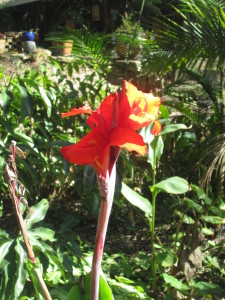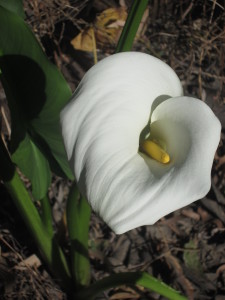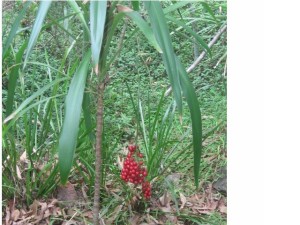___________________________________________________________________________
Note: I would like to share with you through these few words, photographs and hyperlinked websites, a 3 Dimensional experience as though you were actually there with us. Click on any photograph and it should enlarge to different size ….. at least half screen or size full screen. It will be clearer in detail than the photo on the post. It will be as if you were really there looking at the actual scene. You are an arm chair traveller with us.
____________________________________________________________________________
……. A native rainforest tree, the Native Gardenia called Randia Fitzalanii …. see the many images of
the tree. It grows as a woody shrub or small tree some 3–10 m (9.8–32.8 ft) in height.
The trunk is covered by smooth grey bark. The large glossy dark green leaves are obovate
to oval-shaped and range from 10–18 cm (3.9–7.1 in) long by 3–5 cm (1.2–2.0 in) wide.
The yellowish veins and midrib are prominent on the leaf. The new growth is a bright lime green
in colour. The small (2-2.5 cm or 1 inch) white fragrant flowers appear from September to November,
occur singly and have five lanceolate petals around a tube. The round- or oval-shaped fruit is 3–4 cm
in diameter and ripens in April to June. The fragrance of the flowers resembles
that of the common gardenia, and fruit can be eaten fresh…….
….. Bangalow Palms above and below ….
______________________________________
… Newly Planted Rainforest Garden area from 2012 ….

… The garden area in April 2016 …. four years on from 2012 when the garden was planted ….
…. a small section of our rainforest garden …. it has a mixture of bangalow palms
(Australian rainforest palms) and colourful broad leaved subtropical plants such as
the red flowered Canna lily and the white – whorled Arum lily below ….



_________________________________________________
The Rest of the Rainforest Garden Room
 … Possum in the branches of a low growing rainforest tree in the middle of
… Possum in the branches of a low growing rainforest tree in the middle of
the day …. instead of night when they come out ……
From Wikipedia, the free encyclopedia: Alocasia macrorrhizos is a species of flowering plant in the arum family, Araceae, that it is native to rainforests from Malaysia to Queensland and has long been cultivated on many Pacific islands and elsewhere in the tropics. Common names include Giant Taro and Elephant Ear Taro, while words for the plant in the various Polynesian languages include Kape (Futunan, Niuean, Tongan, Wallisian), ʻApe (Cook Islands Māori, Tahitian, Hawaiian), “ta’amu” in Samoan language, and Pulaka (Tuvalu). In Australia it is known as the “cunjevoi” (although that term also refers to a marine animal). It is edible if cooked for a long time but its sap irritates the skin due to calcium oxalate crystals, or raphides which are needle like. Alocasia species are commonly found in marketplaces in Samoa and Tonga and other parts of Polynesia. The varieties recognized in Tahiti are the Ape oa, haparu, maota, and uahea. The giant heart-shaped leaves make impromptu umbrellas in tropical downpours.
__________________________________________________________







